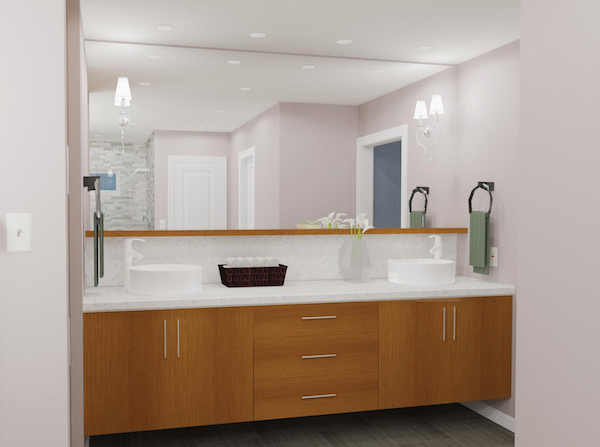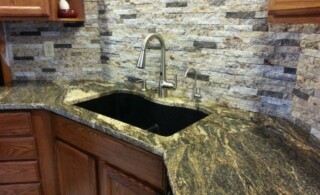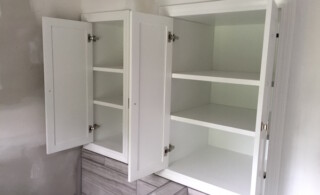On This Page:
- Choosing a Vanity
- How to Install or Replace a Vanity
- Considerations
- Cost to Install or Replace the Vanity
- Conclusion
No matter the style of your bathroom, your vanity is likely a centerpiece of the space. You use it more than most pieces of furniture in the house, making it both a functional and stylistic necessity in any home.
As a result, replacing or installing a vanity is an easy way to accomplish a bathroom makeover. Even if you leave everything else in the room as-is, it will improve the space significantly. Here’s what you should consider during your bathroom vanity installation.
Choosing a Vanity
Before even thinking about installing a new vanity, you need to find one that fits both your needs and style. The two basic types of bathroom vanities are freestanding (which functions especially well for small spaces) and built-in (which offers more storage and counter space but also requires more space and labor). Sizes range from 12 to 84 inches in width and 17 to 24 inches in depth.
Types of Vanities
When choosing your vanity, it’s important to think about the material. You want one that’s sturdy and matches your decor. Here are some common types of vanities you might consider installing:
- Wood: You can get wood vanities made of oak, mahogany or more inorganic looking types of material. The natural wood vanities will cost more and probably last longer. You can also better match your bathroom decor by painting the wood if needed.
- Glass: These types of vanities fit very modern or contemporary bathroom designs. The vanity is designed with a mix of glass, steel and wood for best appearance and strength. You can get glass vanities with very open designs or the typical cabinets and shelves.
- Metal: For those with the ultra sleek metallic look to their bathroom, metal vanities are the way to go. They’re extremely strong, but sometimes it’s harder to find one that exactly matches everything else. There are painting options for metal, but it’s a bit harder than wood.
These materials are by no means the limit. You can get vanities that are mixtures of more than one type, along with pieces that include plastic or other materials in the construction. Remember to keep your budget in mind, along with how the vanity will flow with the rest of the bathroom. Another important aspect to consider is the sink — what kind, how many?
Vanity/Sinktop Combinations
If you decide to combine your vanity and sinktop into one configuration, you have a few decisions to make. How many sinks do you want? What kind of sink will fit best? What kind of plumbing work or modifications are involved? Here are some basic types of combinations to use:
- Single: Simple as it sounds, you have one sink in the vanity.
- Double: This means having two sinks and a longer vanity. This is good for his/her bathroom configurations.
Then you have your choice of sinks as well, including:
- Self-rimming
- Vessel
- Pedestal
- Undermount
If you don’t want to combine the sink with the vanity, you might consider wall-mounted or console sinks as your best option. You’ll have to see what kind of work is involved there, as the wall might need to be knocked out for plumbing.
Ready to start your bathroom vanity?
Find ProsReturn to Top
How to Install or Replace a Vanity
Materials Needed
Having chosen the ideal piece of furniture for your bathroom, it’s time to start thinking about the installation. You may choose to update only the countertop or go with a full replacement that includes plumbing updates. Before you begin, here are some materials that you will need in the process:
- Silicone caulk and caulking gun
- PVC piping according to the needs of your space
- A hacksaw to cut the piping to size as needed
- Water supply tubes, ideally flexible supply hoses
- Two shut-off valves
- Plumber’s putty
- Pipe wrench and pipe cutters
- A bucket and/or paper towels
- A hammer and chisel to remove the existing countertops
- A screwdriver
- Wall stud finder
- A tape measure and pencil
- Paint to patch any damaged spots on the wall, as needed.
Step by Step Guide
- Shut off the water, and turn on the existing faucet to release the water pressure.
- Disconnect the existing trap and water lines, and catch any residual water from your existing plumbing with a bucket.
- Remove the countertop and/or top sink by cutting the existing sealant and using a hammer and chisel to loosen it.
- Detach the vanity cabinet from the wall by loosening the screws.
- Clean up, patch, and paint the wall behind the vanity to take care of any damage the removal may have caused.
- Mark the height and width of the new vanity on the wall, using exact dimensions. Be sure to position the vanity so that the screws to attach it will find your wall studs.
- Build the cabinet part of your vanity, and secure it to the wall using screws.
- Install your faucets to the countertop before attaching the top to the vanity.
- Secure the countertop to the top of the cabinet using caulk, and press firmly to ensure the caulk will connect the two.
- Once the adhesive is dry, it’s time to re-attach the plumbing. Start with the water supply tubes, and add the new PVC piping. You may have to cut it with a hacksaw to get it to fit perfectly.
- Finish the job by applying caulking around the countertop.
Should You DIY?
Taking care of your own vanity installation comes with a number of advantages. Because you are taking care of the labor, it will be less expensive than hiring a professional. In addition, you finish the project knowing that you just took care of improving your home on your own.
Of course, it will also take more time, along with multiple trips to your local home improvement store to make sure you have the right materials. That, in addition to the plumbing work that will likely be required, may lead you to prefer working with a professional instead.
Hiring a Contractor
If you choose to go with a professional contractor for your vanity install, you need to make sure to find the right one. Always be sure to ask about the following topics:
- The professional’s experience, training, licensing, and insurance to make sure they’re qualified for the project.
- The potential of a warranty for the job, along with estimates on how long the job will take and whether any homeowners permits are required.
- Any references the contractor has for past work who you can ask about satisfaction and recommendation.
Ready to start your bathroom vanity?
Find ProsReturn to Top
Considerations
Is Plumbing Involved?
That depends entirely on the scope of your project. Simply replacing your vanity countertop, for example, only requires attaching a new faucet to your existing plumbing. On the other hand, a complete install probably will include cutting re-routing pipes for the perfect fit and possibly even cutting holes in the vanity itself.
For most updates or replacements, you should think about replacing your water supply lines and shut-off valves. If you don’t get the plumbing right, you may invite issues with dripping water down the road, so be sure you’re comfortable with the amount of plumbing involved before embarking on the project.
Should You Get a Single or Double Sink?
The answer to that question will likely come down to who uses the bathroom, and how often multiple people need easy access to the faucet at one time. A double-sink vanity is perfect especially for families. But don’t underestimate the amount of space it will take up in your bathroom as well as the added cost.
Bathroom Design
The fact that your vanity is the centerpiece of your bathroom also means that its design and style will make a major impact on the room’s overall look and feel. Choose the vanity that works best for you, both in terms of size and the style of the furniture and its fixtures.
For example, you can choose one that integrates your sink into the countertop, or an alternative that features the sink on top of the vanity. Bathroom vanities enable you to get creative, adding a personal note to a functional space.
Materials
When choosing a vanity, always consider the materials with which it’s built. Countertops can range from granite to marble, while the cabinet itself may be built in composite, metal, or various types of wood.
Of course, your options when it comes to sinks also range widely. You can go with a vanity that integrates your sink into the countertop, or an alternative that features the sink on top.
Materials will impact both the piece’s style and its quality, so make sure you choose a vanity that works with your vision and your budget.
Ready to start your bathroom vanity?
Find ProsReturn to Top
Cost to Install or Replace the Vanity
First, you should consider the cost of the furniture itself. Vanities can range from $39.99 for a small, single-sink option to a luxurious, 72 inch wide double-sink alternative that comes with a price tag of more than $3,000. Of course, that may not include faucets, which can range from $12.39 to more than $1,000 depending on your needs and preferences.
Estimating Your DIY Costs
In addition to the above costs of the furniture itself, installing a vanity yourself will only incur material costs. If you already own the right tools and only need materials, you can get everything you need for less than $50.
Evaluating Contractor Quotes
If you can put the cabinets together yourself, a typical bathroom contractor will likely charge you between $200 and $400 for the installation. Exact costs, of course, differ based on the size of the vanity and the complexity of the plumbing.
Conclusion
Installing a new vanity in your bathroom can significantly improve your space, but also comes with a number of considerations you need to keep in mind. What vanity do you want? What steps do you need to take to do your own install, or does hiring a professional make more sense? What plumbing will be involved? While this article should have answered many of your questions about the process, you may still need clarification on what it takes to replace or install a new vanity in your bathroom.
Ready to start your bathroom vanity?
Find Pros

 3 Bathroom Remodels You Can Afford RIGHT NOW
3 Bathroom Remodels You Can Afford RIGHT NOW  Corner Bathroom and Kitchen Sinks
Corner Bathroom and Kitchen Sinks  Towel Storage
Towel Storage  Bathroom Cabinets
Bathroom Cabinets  Customize Your Toilet with a Bidet Faucet
Customize Your Toilet with a Bidet Faucet 

Are You Familiar With This Topic? Share Your Experience.